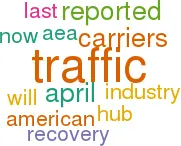Recovery patterns
June 2002


The pattern of airline industry recovery is now becoming a bit clearer. Traffic numbers are edging up, but the latest annual changes being reported are usually still negative. AEA intra–Europe and US domestic traffic was down by 9% and 11% respectively in April. As for the Asian/Pacific carriers (AAPA), their intra–region traffic in March, the latest available month, was actually up 5%.
It’s the long–hauls that continue to disappoint. AEA transatlantic traffic was down 21% in April while that of the US majors showed a 16% decline. On the transpacific US carriers were down 16% while AAPA airlines reported a traffic fall of 5%. Europe–Asia routes are now positive, around 5%, for both European and Asian carriers.
What this seems to mean is that Asia/Pacific has returned to almost normal traffic levels, Europe is moving up slowly (and the AEA numbers do not show the impact of the low–costs) but US traffic, especially international, seems very depressed.
However, the US carriers are making a concerted effort to keep capacity down, push up load factors and improve yields. There is actually some evidence of yield recovery: in April average US domestic fares were down 12% compared to 25% in the latter months of last year. International fares were down only 2% in April. Confidence is seeping back into the industry. It will be interesting to observe the psychological impact of the growth levels that will be reported after September this year. Pursuing current trends, we would expect monthly traffic growth to be reported at 20%-plus (against of course an extremely depressed base period).
It has become clear that there will not be a full–scale restructuring of the industry though we expect the Euro–rationalisation process to continue, with at least another two flag–carrier bankruptcies in the next six months or so.
In the US all aspects of the established airline model are now being re–examined. Don Carty, CEO of American, focused on two issues at a recent Merrill Lynch conference: First, a legislative solution to impasses in union negotiations: a form of mandatory arbitration based on the "last best offer" approach. After a period of negotiation, management and labour would have to provide a last best offer to arbitrators, who would then choose one or the other. This, according to Carty, would force both sides to the centre, and avoid a scenario in which the bargaining leverage belongs to the party that can impose a strike.
Second, American is reconsidering the way its hub system works, specifically the trade–off between revenues and the relative inefficiencies that highly–peaked hub schedules tend to drive. The implication is that American may move back to more of a rolling hub concept in an effort to improve labour efficiency and aircraft utilisation at the expense of maximising connections.